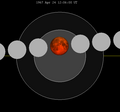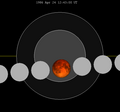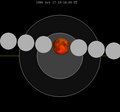April 1986 lunar eclipse
| Total eclipse | |||||||||||||||||
 The Moon's hourly motion shown right to left | |||||||||||||||||
| Date | April 24, 1986 | ||||||||||||||||
|---|---|---|---|---|---|---|---|---|---|---|---|---|---|---|---|---|---|
| Gamma | −0.3683 | ||||||||||||||||
| Magnitude | 1.2022 | ||||||||||||||||
| Saros cycle | 131 (32 of 72) | ||||||||||||||||
| Totality | 63 minutes, 35 seconds | ||||||||||||||||
| Partiality | 198 minutes, 45 seconds | ||||||||||||||||
| Penumbral | 312 minutes, 37 seconds | ||||||||||||||||
| |||||||||||||||||
A total lunar eclipse occurred at the Moon’s descending node of orbit on Thursday, April 24, 1986,[1] with an umbral magnitude of 1.2022. A lunar eclipse occurs when the Moon moves into the Earth's shadow, causing the Moon to be darkened. A total lunar eclipse occurs when the Moon's near side entirely passes into the Earth's umbral shadow. Unlike a solar eclipse, which can only be viewed from a relatively small area of the world, a lunar eclipse may be viewed from anywhere on the night side of Earth. A total lunar eclipse can last up to nearly two hours, while a total solar eclipse lasts only a few minutes at any given place, because the Moon's shadow is smaller. Occurring about 1.25 days before perigee (on April 25, 1986, at 18:40 UTC), the Moon's apparent diameter was larger.[2]
This lunar eclipse was the third of a tetrad, with four total lunar eclipses in series, the others being on May 4, 1985; October 28, 1985; and October 17, 1986.
Visibility
[edit]The eclipse was completely visible over Australia, east and northeast Asia, Antarctica, and the western and central Pacific Ocean, seen rising over much of Asia and setting over North America and western South America.[3]
  |
Eclipse details
[edit]Shown below is a table displaying details about this particular solar eclipse. It describes various parameters pertaining to this eclipse.[4]
| Parameter | Value |
|---|---|
| Penumbral Magnitude | 2.16203 |
| Umbral Magnitude | 1.20217 |
| Gamma | −0.36826 |
| Sun Right Ascension | 02h07m09.8s |
| Sun Declination | +12°52'05.8" |
| Sun Semi-Diameter | 15'54.1" |
| Sun Equatorial Horizontal Parallax | 08.7" |
| Moon Right Ascension | 14h06m30.3s |
| Moon Declination | -13°12'18.9" |
| Moon Semi-Diameter | 16'34.0" |
| Moon Equatorial Horizontal Parallax | 1°00'48.0" |
| ΔT | 55.0 s |
Eclipse season
[edit]This eclipse is part of an eclipse season, a period, roughly every six months, when eclipses occur. Only two (or occasionally three) eclipse seasons occur each year, and each season lasts about 35 days and repeats just short of six months (173 days) later; thus two full eclipse seasons always occur each year. Either two or three eclipses happen each eclipse season. In the sequence below, each eclipse is separated by a fortnight.
| April 9 Ascending node (new moon) | April 24 Descending node (full moon) |
|---|---|
 |  |
| Partial solar eclipse Solar Saros 119 | Total lunar eclipse Lunar Saros 131 |
Related eclipses
[edit]Eclipses in 1986
[edit]- A partial solar eclipse on April 9.
- A total lunar eclipse on April 24.
- A hybrid solar eclipse on October 3.
- A total lunar eclipse on October 17.
Metonic
[edit]- Preceded by: Lunar eclipse of July 6, 1982
- Followed by: Lunar eclipse of February 9, 1990
Tzolkinex
[edit]- Preceded by: Lunar eclipse of March 13, 1979
- Followed by: Lunar eclipse of June 4, 1993
Half-Saros
[edit]- Preceded by: Solar eclipse of April 18, 1977
- Followed by: Solar eclipse of April 29, 1995
Tritos
[edit]- Preceded by: Lunar eclipse of May 25, 1975
- Followed by: Lunar eclipse of March 24, 1997
Lunar Saros 131
[edit]- Preceded by: Lunar eclipse of April 13, 1968
- Followed by: Lunar eclipse of May 4, 2004
Inex
[edit]- Preceded by: Lunar eclipse of May 13, 1957
- Followed by: Lunar eclipse of April 4, 2015
Triad
[edit]- Preceded by: Lunar eclipse of June 23, 1899
- Followed by: Lunar eclipse of February 22, 2073
Lunar eclipses of 1984–1987
[edit]This eclipse is a member of a semester series. An eclipse in a semester series of lunar eclipses repeats approximately every 177 days and 4 hours (a semester) at alternating nodes of the Moon's orbit.[5]
The penumbral lunar eclipse on June 13, 1984 occurs in the previous lunar year eclipse set.
| Lunar eclipse series sets from 1984 to 1987 | ||||||||
|---|---|---|---|---|---|---|---|---|
| Descending node | Ascending node | |||||||
| Saros | Date Viewing | Type Chart | Gamma | Saros | Date Viewing | Type Chart | Gamma | |
| 111 | 1984 May 15 | Penumbral | 1.1131 | 116 | 1984 Nov 08 | Penumbral | −1.0900 | |
| 121 | 1985 May 04 | Total | 0.3520 | 126 | 1985 Oct 28 | Total | −0.4022 | |
| 131 | 1986 Apr 24 | Total | −0.3683 | 136 | 1986 Oct 17 | Total | 0.3189 | |
| 141 | 1987 Apr 14 | Penumbral | −1.1364 | 146 | 1987 Oct 07 | Penumbral | 1.0189 | |
Metonic series
[edit]This eclipse is the third of four Metonic cycle lunar eclipses on the same date, April 23–24, each separated by 19 years:
The Metonic cycle repeats nearly exactly every 19 years and represents a Saros cycle plus one lunar year. Because it occurs on the same calendar date, the Earth's shadow will in nearly the same location relative to the background stars.
| Descending node | Ascending node | |||||
|---|---|---|---|---|---|---|
| Saros | Date | Type | Saros | Date | Type | |
| 111 | 1948 Apr 23 | Partial | 116 | 1948 Oct 18 | Penumbral | |
 |  | |||||
| 121 | 1967 Apr 24 | Total | 126 | 1967 Oct 18 | Total | |
 |  | |||||
| 131 | 1986 Apr 24 | Total | 136 | 1986 Oct 17 | Total | |
 |  | |||||
| 141 | 2005 Apr 24 | Penumbral | 146 | 2005 Oct 17 | Partial | |
 |  | |||||
Saros 131
[edit]This eclipse is a part of Saros series 131, repeating every 18 years, 11 days, and containing 72 events. The series started with a penumbral lunar eclipse on May 10, 1427. It contains partial eclipses from July 25, 1553 through March 22, 1932; total eclipses from April 2, 1950 through September 3, 2202; and a second set of partial eclipses from September 13, 2220 through April 9, 2563. The series ends at member 72 as a penumbral eclipse on July 7, 2707.
The longest duration of totality will be produced by member 38 at 100 minutes, 36 seconds on June 28, 2094. All eclipses in this series occur at the Moon’s descending node of orbit.[6]
| Greatest | First | |||
|---|---|---|---|---|
 The greatest eclipse of the series will occur on 2094 Jun 28, lasting 100 minutes, 36 seconds.[7] | Penumbral | Partial | Total | Central |
| 1427 May 10 | 1553 Jul 25 | 1950 Apr 02 | 2022 May 16 | |
| Last | ||||
| Central | Total | Partial | Penumbral | |
| 2148 Jul 31 | 2202 Sep 03 | 2563 Apr 09 | 2707 Jul 07 | |
Eclipses are tabulated in three columns; every third eclipse in the same column is one exeligmos apart, so they all cast shadows over approximately the same parts of the Earth.
| Series members 22–43 occur between 1801 and 2200: | |||||
|---|---|---|---|---|---|
| 22 | 23 | 24 | |||
| 1806 Jan 05 | 1824 Jan 16 | 1842 Jan 26 | |||
| 25 | 26 | 27 | |||
| 1860 Feb 07 | 1878 Feb 17 | 1896 Feb 28 | |||
| 28 | 29 | 30 | |||
| 1914 Mar 12 | 1932 Mar 22 | 1950 Apr 02 | |||
 |  |  |  |  |  |
| 31 | 32 | 33 | |||
| 1968 Apr 13 | 1986 Apr 24 | 2004 May 04 | |||
 |  |  |  |  |  |
| 34 | 35 | 36 | |||
| 2022 May 16 | 2040 May 26 | 2058 Jun 06 | |||
 |  |  |  |  |  |
| 37 | 38 | 39 | |||
| 2076 Jun 17 | 2094 Jun 28 | 2112 Jul 09 | |||
 |  |  |  | ||
| 40 | 41 | 42 | |||
| 2130 Jul 21 | 2148 Jul 31 | 2166 Aug 11 | |||
| 43 | |||||
| 2184 Aug 21 | |||||
Half-Saros cycle
[edit]A lunar eclipse will be preceded and followed by solar eclipses by 9 years and 5.5 days (a half saros).[8] This lunar eclipse is related to two annular solar eclipses of Solar Saros 138.
| April 18, 1977 | April 29, 1995 |
|---|---|
 |  |
See also
[edit]Notes
[edit]- ^ "April 24–25, 1986 Total Lunar Eclipse (Blood Moon)". timeanddate. Retrieved 6 January 2025.
- ^ "Moon Distances for London, United Kingdom, England". timeanddate. Retrieved 6 January 2025.
- ^ "Total Lunar Eclipse of 1986 Apr 24" (PDF). NASA. Retrieved 6 January 2025.
- ^ "Total Lunar Eclipse of 1986 Apr 24". EclipseWise.com. Retrieved 6 January 2025.
- ^ van Gent, R.H. "Solar- and Lunar-Eclipse Predictions from Antiquity to the Present". A Catalogue of Eclipse Cycles. Utrecht University. Retrieved 6 October 2018.
- ^ "NASA - Catalog of Lunar Eclipses of Saros 131". eclipse.gsfc.nasa.gov.
- ^ Listing of Eclipses of series 131
- ^ Mathematical Astronomy Morsels, Jean Meeus, p.110, Chapter 18, The half-saros
External links
[edit]- 1986 Apr 24 chart Eclipse Predictions by Fred Espenak, NASA/GSFC


 French
French Deutsch
Deutsch

